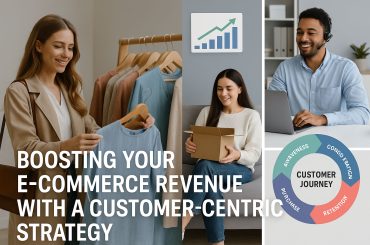Introduction: Why “More Traffic” Isn’t Always the Answer
Ask most e-commerce founders how they plan to grow and they’ll say: “We need more traffic.” That’s understandable—but short-sighted. Because before chasing new visitors, it’s far more profitable to convert more of the traffic you already have.
Conversion Rate Optimization (CRO) is not about random experiments or split-testing button colors. It’s about creating a smoother, smarter, and psychologically aligned buyer journey. It’s about empathy. Clarity. Motivation. And removing every small point of friction that makes someone pause just before purchasing.
In this essay, we explore 10 battle-tested, data-backed tactics that move the needle—not hypothetically, but measurably. Whether you run a growing Shopify store or a multi-product WooCommerce site, these tactics are designed to help you convert more visitors into customers—with confidence.
Tactic 1: Use High-Quality, Contextual Product Imagery
One of the first and most immediate trust signals on any product page is imagery. Yet too many stores settle for sterile white-background shots alone.
What to Do:
- Include lifestyle images (product in real-world use)
- Add interactive 360° views or zoomable detail shots
- Show the product in context of size, fit, or environment
- Use video demonstrations where possible
Why It Works:
People don’t just want to see what you sell—they want to imagine using it. Context reduces uncertainty and builds desire.
Tactic 2: Rewrite Product Descriptions to Sell Benefits, Not Just Features
A common mistake: listing features like a technical manual. What your visitors actually want is to understand how your product makes their life better.
Before:
“Made of 100% Egyptian cotton. Machine washable. 500-thread count.”
After:
“Soft enough to make you forget you’re not at a luxury resort. Durable enough for everyday spills and spin cycles.”
Format to Follow:
- Open with a hook or transformation (“Finally, sleep like you mean it…”)
- Use short bullets for features
- Weave in emotional language and sensory triggers
Tactic 3: Simplify Navigation and Product Discovery
Confused visitors don’t convert—they bounce. Your site architecture should mirror buyer logic, not your internal SKU system.
Quick Wins:
- Reduce top menu items to under 6
- Add “Shop by Problem” or “Shop by Use Case” categories
- Use search with smart suggestions and spelling correction
- Implement filters that are meaningful (e.g., “Best for oily skin” not just “moisturizers”)
Pro Tip:
Watch user behavior via tools like Hotjar or Microsoft Clarity to spot where users are hesitating or getting lost.
Tactic 4: Speed Up Your Site. Seriously.
A 1-second delay in load time can reduce conversions by 7%. In e-commerce, speed isn’t a tech issue—it’s a revenue multiplier.
What to Fix:
- Compress images (use WebP where possible)
- Minimize use of plugins/scripts
- Host on a CDN (Content Delivery Network)
- Enable lazy loading for below-the-fold content
Test your site on mobile with PageSpeed Insights.
Tactic 5: Add Social Proof Where It Matters Most
Testimonials are great, but placement and specificity matter more.
Placement:
- On product pages
- Below add-to-cart buttons
- Inside email sequences
- On exit-intent popups (“Still unsure? See what others say…”)
Pro Tip:
Use visual social proof—UGC photos, star ratings, and short quotes with names and faces. Specific outcomes (“My skin cleared in 3 weeks”) beat generic praise.
Tactic 6: Offer a Clear, Risk-Reducing Return Policy
Nothing tanks a conversion like hidden or vague return details. Reassure your buyer before they click “Add to Cart.”
What to Include:
- “30-day no-hassle returns”
- “Full refund if you’re not satisfied”
- Clear contact and process steps
- Visible badge near checkout and product pages
The more confident you sound, the more confident they feel.
Tactic 7: Create Scarcity or Urgency Without Manipulation
Fear-based urgency feels pushy. But strategic urgency? It gives buyers a reason to act now, not “someday.”
Ethical Examples:
- “Only 3 left in stock” (based on live inventory)
- “Order in the next 2 hours for same-day shipping”
- “Limited restock—join the waitlist if we sell out again”
- “Holiday bundle available this week only”
Tools:
Use apps like FOMO or Testimonial.to to show real-time buyer activity.
Tactic 8: Optimize Your Checkout Flow for Speed and Confidence
Your checkout page should feel like a glide, not a gauntlet.
Best Practices:
- Use progress indicators
- Offer guest checkout (don’t force account creation)
- Minimize form fields (combine first/last name)
- Include trust badges (SSL, payment icons, review sites)
- Show return policy again (yes, here too)
And always have a mobile-optimized version. In 2025, over 70% of carts are completed on mobile devices.
Tactic 9: Use Email Abandonment Sequences That Actually Help
70%+ of online carts are abandoned. A single recovery email is not enough.
Your 3-Email Recovery Flow:
- Reminder (1 hour later): “Still thinking it over?”
- Reinforce Value (1 day later): “Why customers love this” + reviews
- Soft Incentive (2–3 days later): “Here’s 10% off—it’s still waiting for you.”
Always test with and without discount. Sometimes a reminder is all it takes.
Tactic 10: Test, Track, and Learn—Continuously
No tactic works in isolation. And no funnel is ever finished.
What to Track:
- Conversion rate by product
- Time on page
- Scroll depth
- Exit rate
- Cart abandonment rate
- Click maps and tap heatmaps
Use A/B testing tools like Google Optimize, Convert, or VWO to test:
- Headlines
- CTA button copy
- Image styles
- Price anchoring (e.g., “Was $70, now $49”)
Final Thoughts: Conversion Is a Conversation
Improving conversion rates isn’t about manipulation. It’s about clarity, trust, and experience.
When you start thinking like a guide, not a seller…
When you align your store with the way people think, shop, hesitate, and decide…
You don’t just convert more customers—you build a stronger brand.
Because at the end of every abandoned cart is a confused human.
And at the heart of every great conversion is a decision that felt right.
So use these 10 tactics not just as tricks, but as tools. Tools to help people say “yes” with ease, and come back again with confidence.




